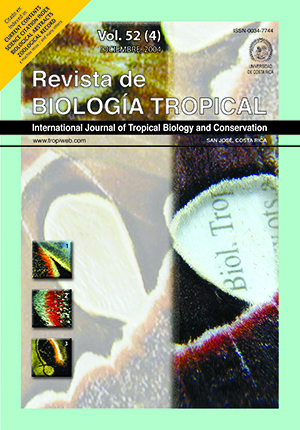Abstract
The feeding ecology of Turdus pelios was studied from field observations and gizzard contents. Quantitative data on feeding were obtained from repeated standard “fixed route” walks and observational points at seven sites from January to December 1998 on 5065ha at the Obafemi Awolowo University campus, Ile-Ife (7º20’ N, 4º33’ E). Walks (each lasting about two hours) were started at various times of the day between 7.00 and 16.45 h. A total of 100 walks were made and binoculars were used to observe all feeding activities during 10 minutes at each site. Each feeding record included food type, method of feeding and reaction with con-specifics at feeding sites. Gizzards from mist-netted specimens were also studied. These birds fed most commonly twice a day between 06.00-9.30hr in the morning and between 17.00-18.30hr in the evening. Field observations showed that about 62% of the diet consisted of plant matter. The prey items were earthworms and terrestrial arthropods, of which orthopterans alone constituted 45% of the total. The prey size consumed by both sexes overlapped extensively: differences in prey size were significant only for spidersReferences
Akinpelu, A.I. 1992. Studies on the reproductive activitiesof three estrildid birds (Family: Estrildidae) in Ile-Ife, Nigeria. Ph.D. Thesis. Obafemi Awolowo University, Ile-Ife.
Akinpelu, A.I. 2004. A twelve-month field study of the West African Thrush Turdus pelios (Passeriformes:
Muscicapidae) Part 2: annual cycles. Rev. Biol. Trop. 53: in press.
Borror, D.J., D.M. De Long & C.A. Triplehorn. 1981. An introduction to the study of insects. Saunders College
Publ., New York.
Earle, R.A. 1981. Factors governing avian breeding in Acacia Savanna. Pietermaritzburg. Part 1: Extrinsic factors. Ostrich 52(2): 65-83.
Earle, R.A. & T.B. Oatley. 1983. Populations, ecology and breeding of the Orange Thrush at two sites in eastern
South Africa. Ostrich 54: 205-212.
Jordano, P. 1984. Seed weight variation and differential avian dispersal in blackberries Rubus ulmifolius.
Oikos 43: 149-153.
Oatley, T.B. 1982. The Starred Robin in Natal. Part 2: Annual cycles and feeding ecology. Ostrich 53(4): 193-221.
Rosenberg, K.V., R.D. Ohmart & B.W. Anderson. 1982. Community organization in riparian birds: response to an annual resource peak. Auk 99: 260-274.
Rosenberg, K.V. & R.J. Cooper. 1990. Approaches to avian diet analysis. In M.L. Morrison, C.J. Ralph, J. Verner
& J.R. Jehl, Jr (eds.). Avian foraging: theory, methodology and applications. Studies in Avian Biology No: 13: 80-90.
Pough, F.H., B.H. John & N.M. William. 1989. Vertebrate life. Macmillan, New York.
Wiens, J.A. & J.T. Rotenberry. 1979. Diet niche relationships among North American grasslands and shrubsteppe
birds. Oecologia 42: 253-292.
Comments

This work is licensed under a Creative Commons Attribution 4.0 International License.
Copyright (c) 2004 Revista de Biología Tropical


